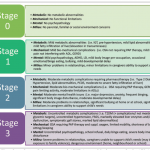
The Edmonton Obesity Staging System for Pediatrics
Regular readers are by now familiar with the Edmonton Obesity Staging System (EOSS), that classifies individuals with obesity based on its impact on physical, mental and functional health.
Now, Stasia Hadjiyannakis and colleagues present an adaptation of EOSS for kids, published in Pediatrics and Child Health.
The evidence-informed paediatric clinical obesity staging system (EOSS-P), builds on EOSS for adults and captures the severity of disease, as well as factors that complicate management, within four domains of health most commonly encountered in obesity:
The EOSS-P assesses four main domains that are impacted by obesity and can impact responsiveness to weight management – metabolic, mechanical, mental, milieu:
Metabolic
Metabolic complications of paediatric obesity include glucose dysregulation (including type 2 diabetes [T2D]), dyslipidemia, the metabolic syndrome, nonalcoholic fatty liver disease, hypertension and, in adolescent females, polycystic ovary syndrome. Metabolic complications are often asymptomatic and must be screened for to be identified. Screening should begin at two years of age for lipid disorders, three years of age for hypertension and at 10 years of age or at the onset of puberty, if this occurs earlier, for diabetes. Metabolic complications of obesity can improve significantly through changes in health behaviour with minimal change in BMI.
Mechanical
Biomechanical complications of paediatric obesity include sleep apnea, sleep disordered breathing, gastroesophageal reflux disease, and musculoskeletal pain and dysfunction. The presence of sleep apnea and/or sleep disordered breathing can exacerbate the metabolic complications of obesity, have deleterious neurobehavioural effects, and affect appetite and food intake. Biomechanical complications can be barriers to weight management and affect prognosis. If left inadequately treated, biomechanical complications of obesity can promote further weight gain.
Mental health
Children and youth with obesity are at risk for social isolation and stigmatization. Childhood psychiatric disorders (eg, depression, anxiety), school difficulties, body dissatisfaction, dysregulated eating behaviours, teasing and bullying have all been linked to paediatric obesity. Children and youth with obesity have consistently reported lower health-related quality of life compared with normative samples. Mental health disorders, as well as some of the pharmacotherapeutic agents that are used to manage them, can complicate weight management, promote weight gain and affect prognosis.
Social milieu
An assessment of the family, school and neighbourhood milieus (the social milieu) is unique to the paediatric staging system and is important given the key role that parents, family members, schools and communities/neighbourhoods play in the health and wellbeing of children and youth. School difficulties and family factors, such as poor parental health, maternal depression, poor family functioning, receipt of social assistance, lack of emotional support, single parenthood and maternal drug use, have been associated with childhood obesity. Exposure to greater levels of psychosocial stress has been associated with higher levels of self-reported illness and negative health outcomes. Parental involvement and support are integral to successful paediatric obesity management.
The EOSS-P can be applied to children with obesity who are ?2 years of age. The staging system is a tool reliant on clinician ratings, which are based on common clinical assessments including medical history, clinical examination and routine investigations. The EOSS-P is based on the presence and degree of the 4Ms with four stages of increasing health risk severity (0, 1, 2 and 3). The 4Ms are distinct categories, and progression in one of the categories does not necessarily coincide with a concomitant increase in the others. Individuals are assigned the highest stage in which they present with any metabolic, mechanical, mental health or social milieu risk factors.
As the authors note,
“This assessment tool can help support improved clinical and administrative decisions regarding the allocation of resources (ie, human, financial, time) for obesity management, and provide a platform for future research and clinical care designed to individualize therapeutic options.”
I have little doubt that clinicians will welcome this adaptation of EOSS for pediatric care as enthusiastically as they have welcomed the adult version of EOSS.
@DrSharma
Vancouver, BC
(c) Dr. Sharma’s Obesity Notes – Read entire story here.


